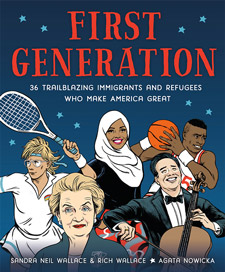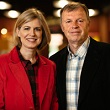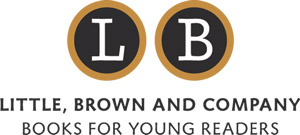#BooksOpenBorders: A Q&A With The Authors of First Generation: 36 Trailblazing Immigrants and Refugees Who Make America Great
First Generation shows that immigrants and refugees want what everyone wants. We’re connected by our mutual desire for opportunities, a better life, and to be with family. When we learn of the hardships newcomers faced to not only build a new life in America but to make this country even greater, all barriers melt and we’re inspired and reminded of how precious it is to live in the United States.

What does #BooksOpenBorders mean to you and how does your book help open hearts, minds, and borders?
 Sandra Neil Wallace: First Generation shows that immigrants and refugees want what everyone wants. We’re connected by our mutual desire for opportunities, a better life, and to be with family. When we learn of the hardships newcomers faced to not only build a new life in America but to make this country even greater, all barriers melt and we’re inspired and reminded of how precious it is to live in the United States.
Sandra Neil Wallace: First Generation shows that immigrants and refugees want what everyone wants. We’re connected by our mutual desire for opportunities, a better life, and to be with family. When we learn of the hardships newcomers faced to not only build a new life in America but to make this country even greater, all barriers melt and we’re inspired and reminded of how precious it is to live in the United States.
Rich Wallace: There’s a strong connection to the present immigration climate, of course. But, I’ve always found that books have helped me cross personal borders in my life, particularly as a teenager. Reading about other people—real or fictional—who were facing barriers in their own lives helped me find pathways for overcoming physical or emotional obstacles. First Generation offers 36 unique lenses through which a reader can examine his or her place in the world.
Please share the inspiration and the impetus of this project.
SNW: I’d been living in the U.S. for years and applied for citizenship in 2016. As I studied for the citizenship test, I read a lot about our founding fathers, but I wasn’t seeing the diversity of America reflected in the questions or the history lessons.
I decided to do some research about laws on my own, and I stumbled on the story of Barbadian-American Barbara Young, a nanny who changed America by championing laws for homecare workers. Barbara reminded me so much of my grandmother, who became a homecare worker when she arrived in Canada as a refugee. Both she and my mother were World War II concentration camp survivors and came from the former Yugoslavia.
At my swearing-in ceremony, I wore the tattered shawl my grandmother had worn in the camps and I stood shoulder-to-shoulder with women from Colombia, the Dominican Republic, China, and other nations. And I thought, why aren’t the people in this room reflected in the books that kids read?
Why is this project important to young readers now?
SNW: The U.S. is a nation of diversity and 13% of the people in this country are immigrants—including me! Immigrants and refugees have faced discrimination throughout history. What’s new and shocking is that this is happening at an accelerated pace in America right now and that it’s part of government policy. This has sparked a national, daily conversation about immigration. We hope that First Generation can counter the negative narrative and spread a positive message about the crucial contributions that immigrants and refugees made (and are still making!) in building America.
RW: Immigrants and refugees are being vilified by every branch of our government, and this has been a constant refrain since the last presidential election cycle. Kids need to know about the wonderful people in our book, who are among the millions of great new Americans.
What does being a “trailblazer” mean to you, and how can young people blaze the trail ahead of them today?
SNW: We consider the people in our book to be trailblazers because they faced extraordinary obstacles yet maintained their self-esteem and persevered. Being a trailblazer also means being true to yourself and doing the right thing—the kind thing—even if it’s unpopular or risky. I wish I’d known that as a kid and had a book like this to read when I was growing up. It would have changed my life.
RW: The readers of this book are of an age where they can make changes by being welcoming to newcomers in their own neighborhoods and classrooms. A smile, a friendly word, an invitation to play games at recess—these gestures can make the world a better place starting on their own scale.
Was there one story that stood out for each of you? What distinguished them?
SNW: It was exciting for me to discover newcomers who became trailblazers in aspects of American life that I wasn’t aware of. Like Belarussian-American Sophia Grojsman. A Jewish refugee and chemist who loved flowers, she became the world’s leading perfumer. I was also struck by the patriotism of our subjects. Olympian Meb Keflezighi wanted to win the Boston Marathon to defy terrorism the year after the bombing. When I learned that he’d written the names of the victims on his race bib, I cried.
RW: I love how Fatimah Hussein drew on her own athletic experiences to empower young Muslim women and provide them with appropriate gear. I love that Carlos Santana was playing guitar in a band all night when he was a kid, then going straight to church to play his violin for the service. I love how Chobani founder Hamdi Ulukaya has transformed two U.S. cities and the lives of thousands of immigrants. I love . . . every one of these stories.
What funny, sad, or inspiring moments jumped out for you both?
SNW: What struck me is how many of the immigrants and refugees featured in our book wouldn’t be allowed to enter this country today or become citizens. Willem de Kooning entered America as a stowaway and became one of the greatest painters in modern American history. Halima Aden resettled in Minnesota as a Somali refugee and is changing the face of fashion as a hijabi model.
RW: Razia Jan building a school for girls in Afghanistan against nearly overwhelming resistance. Architect I.M. Pei recalling his mother taking him to gardens and shrines when he was a little boy. Chef Marcus Samuelsson paying tribute to his grandmother with every dish he cooks.
What is your hope for the young people reading this book?
RW: That it will enhance their innate feelings of empathy and understanding, and that they’ll recognize that the immigrant experience applies to most of their own family histories.
SNW: For children who are immigrants and refugees, we hope they’ll see themselves in First Generation and know that they are acknowledged and appreciated. For kids whose families have been in America for centuries and might be struggling to know their new immigrant and refugee neighbors, learning about the trailblazers in this book can help them forge connections and see how much we all have in common. Like the need to belong and to be loved, to be with family, and to have a purpose in life. Hopefully through these connectors, they’ll see that diversity and difference aren’t things to be afraid of—they’re what make America great.
Click here to enter for your chance to win a collection of books that open borders! Official rules apply.
Listen to Sandra and Rich on the @LBSchool Podcast
Book Details
Title: First Generation: 36 Trailblazing Immigrants and Refugees Who Make America Great
Authors: Sandra Neil Wallace and Rich Wallace

Illustrator: Agata Nowicka
ISBN: 9780316515245
Publication Date: September 4, 2018
Price: $18.99
SPONSORED BY

RELATED
The job outlook in 2030: Librarians will be in demand
The job outlook in 2030: Librarians will be in demand
ALREADY A SUBSCRIBER? LOG IN
We are currently offering this content for free. Sign up now to activate your personal profile, where you can save articles for future viewing






Add Comment :-
Be the first reader to comment.
Comment Policy:
Comment should not be empty !!!